Key takeaways:
- Set clear and meaningful launch goals, focusing on community engagement over just sales numbers.
- Building a targeted audience through authenticity and connection enhances the reader’s emotional investment.
- Crafting a compelling book blurb that highlights emotional stakes captures reader interest effectively.
- Gathering and utilizing feedback from beta readers can refine the narrative and foster a supportive community.
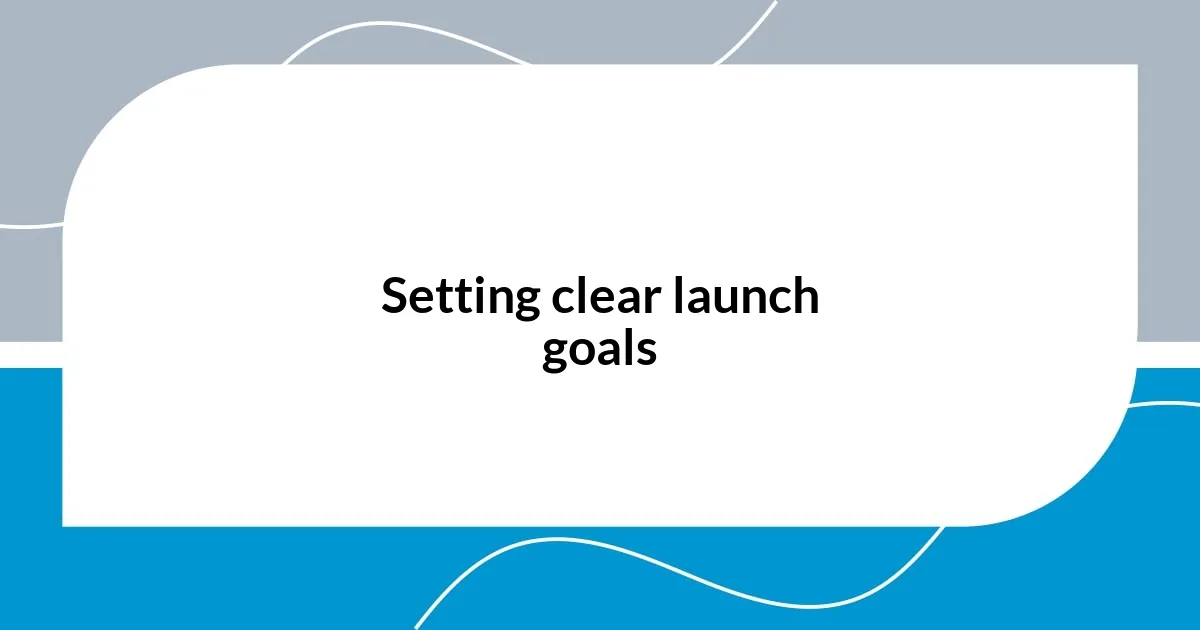
Setting clear launch goals
When I set my launch goals, I often reflect on what success really means to me. Is it the number of books sold, or is it about creating meaningful conversations around my work? For my last book launch, I focused on building a community rather than just hitting sales targets, which transformed my experience into something far richer and more rewarding.
I remember creating a SMART goal—specific, measurable, achievable, relevant, and time-bound. For instance, my target was to engage with 500 readers prior to the launch through social media and targeted events. Breaking it down this way made my aspirations feel less daunting, and I found myself motivated to connect and share my story, which ultimately built excitement around my book.
Setting clear goals isn’t just about numbers; it’s about personal growth and the journey itself. How can you measure the impact of your words on someone’s life? For me, it was heartwarming to receive messages from readers who felt inspired by my previews—those moments reminded me why I wrote the book in the first place.
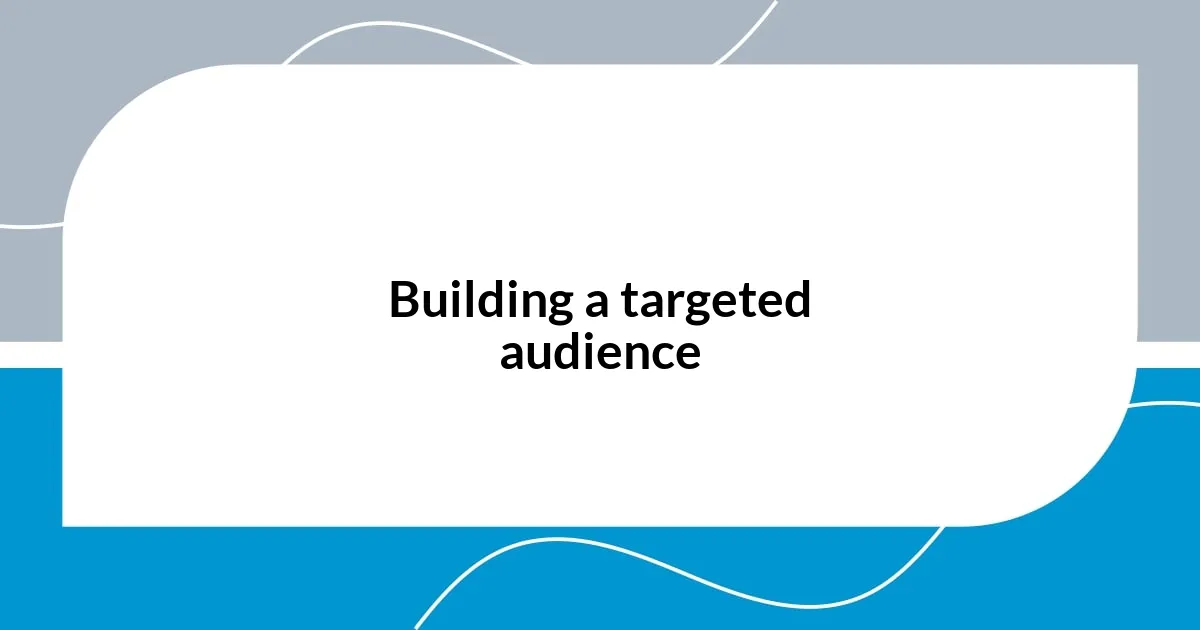
Building a targeted audience
Building a targeted audience was a transformative part of my book launch journey. I realized early on that engaging with potential readers means more than just making announcements; it’s about creating a connection. For example, I hosted virtual book clubs where I could discuss my book’s themes. Seeing participants share their thoughts made me feel like I was already gathering a community around my work even before the launch day.
As I researched my audience, I discovered that tailoring my approach made a significant difference. I began using social media platforms to reach specific demographics, focusing on groups that would find my book appealing. One evening, while scrolling through a writers’ forum, a member shared how my insights resonated with their creative struggles. That moment highlighted the emotional ties I could form by simply engaging with the right people.
To truly connect, I found that authenticity is key. I began sharing snippets of my writing journey, including the challenges I faced. The response was overwhelming; I received countless messages from readers who felt seen and heard. This personal touch not only drew people to my launch but also allowed them to feel a part of my story from the very beginning, fostering a sense of belonging.
| Strategy | Outcome |
|---|---|
| Hosting virtual book clubs | Built community and connection |
| Targeted social media outreach | Attracted the right demographics |
| Sharing personal struggles | Increased reader engagement |
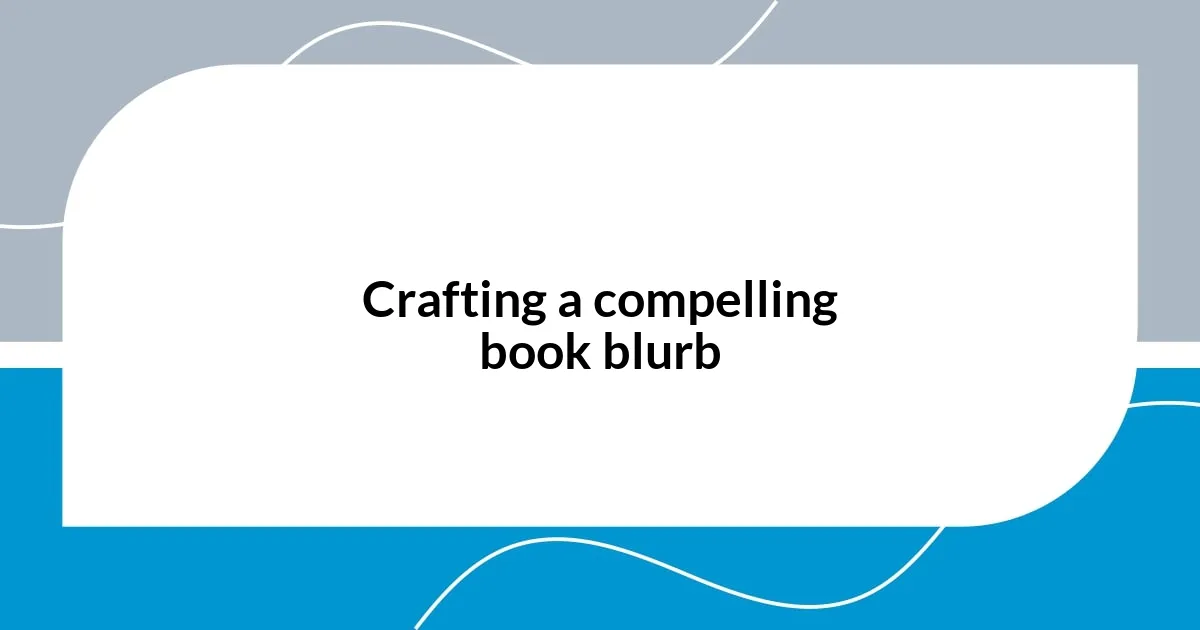
Crafting a compelling book blurb
Crafting a compelling book blurb is truly an art form. I’ve learned that it’s not just a summary; it’s the invitation that beckons readers inside my world. I remember my first blurb draft—loads of details, but it read more like a report than a hook. Through trial and error, I discovered that focusing on the emotional journey and the transformation my characters undergo makes all the difference. Readers want to feel something; they want to escape into a story that promises adventure or connection.
When writing my blurb, I keep these essential elements in mind:
- Hook the reader: Start with an engaging first sentence that raises questions or intrigues.
- Showcase conflict: Highlight the main struggle without giving everything away; curiosity drives readers.
- Highlight the stakes: What do the characters stand to lose? Making this clear draws in the reader emotionally.
For my latest book, I personally reflected on what would captivate me as a reader. I crafted a blurb that answered pivotal questions about the protagonist’s journey, weaving in emotional stakes that resonated with my own experiences. The moment I shared this blurb, I felt a shift—people were not just reading; they were reacting, connecting, and anticipating the adventure ahead. That feeling has been one of the most rewarding aspects of preparing for my launch.

Designing eye-catching promotional materials
Designing eye-catching promotional materials involves a blend of creativity and strategic thinking. I remember sitting at my desk, surrounded by swatches of colors and fonts, pondering which design captured the essence of my book best. It’s like creating a visual language that speaks to potential readers before they even turn a page. For instance, I decided to use bold, warm colors that reflected the emotional tone of my narrative, which helped convey the spirit of the story instantly.
I found that crafting promotional materials wasn’t just about aesthetics; it was about creating a feeling. One memorable moment for me was when I designed a poster that featured a striking quote from my book. I shared it on social media, and the reaction was immediate. Readers were sharing it, commenting on how it resonated with their experiences. This response confirmed that the right visuals can create an emotional connection, drawing in an audience that sees themselves reflected in the imagery.
The takeaway for me was understanding the balance between art and purpose in promotional designs. I experimented with infographics that highlighted key themes of my book while maintaining a cohesive visual style. Each piece became a tool not just for promotion but for storytelling. How could I engage the reader’s curiosity? By using visuals that not only attract the eye but also hint at the deeper journey within the pages, I set the stage for a vibrant connection with my work before the book even hit the shelves.
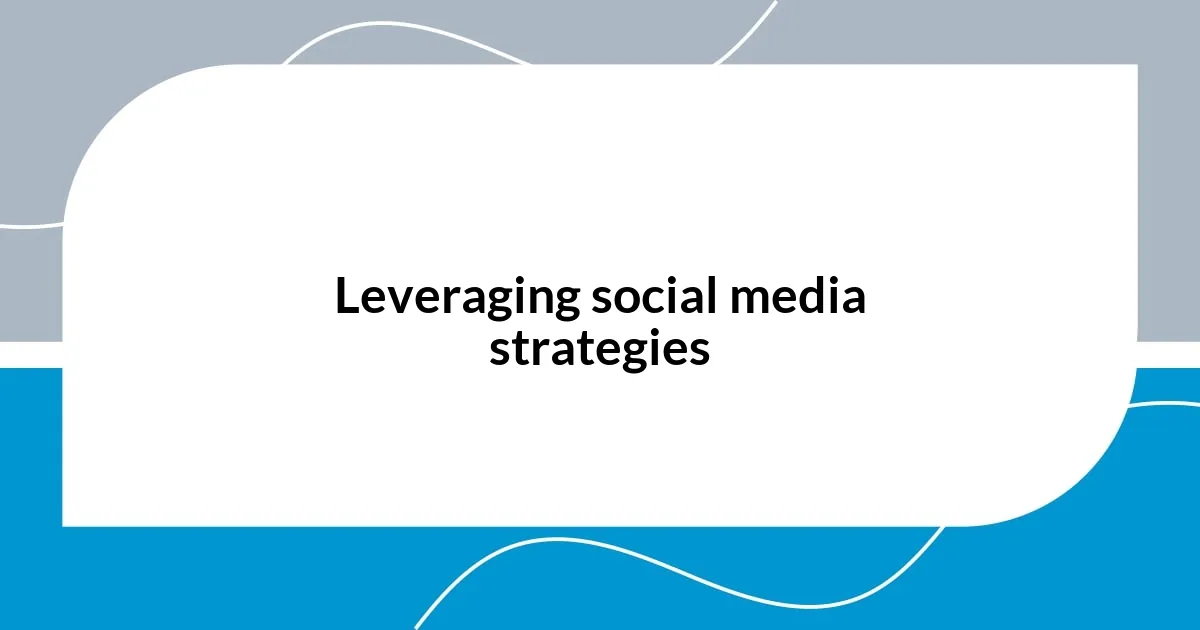
Leveraging social media strategies
I’ve found that leveraging social media strategies is essential for connecting with readers in today’s digital landscape. I remember the excitement and anxiety of planning my first post; I wanted to capture attention without seeming overly promotional. What worked for me was sharing snippets from my writing process, along with engaging visuals of my workspace. This gave followers a behind-the-scenes look at my journey, making it feel more personal and relatable.
Engagement was key. I actively sought feedback by asking readers which cover design they preferred or by inviting them to share their thoughts on character concepts. This not only fostered a sense of community but also made them feel part of the journey. I recall a moment when someone commented that my struggles with a particular chapter mirrored their own creative block. This simple exchange reinforced my belief that authenticity connects us; sharing my vulnerabilities opened the door for deeper conversations.
Utilizing specific platforms also played a significant role in my strategy. I discovered that Instagram allowed for a vibrant visual narrative, while Twitter was perfect for quick updates and engaging discussions. Crafting tweets that posed thought-provoking questions drew in responses, turning followers into active participants. Looking back, I realized that the more I interacted, the more invested my audience became. It’s all about creating moments of connection—after all, isn’t it those connections that make the writing journey meaningful?
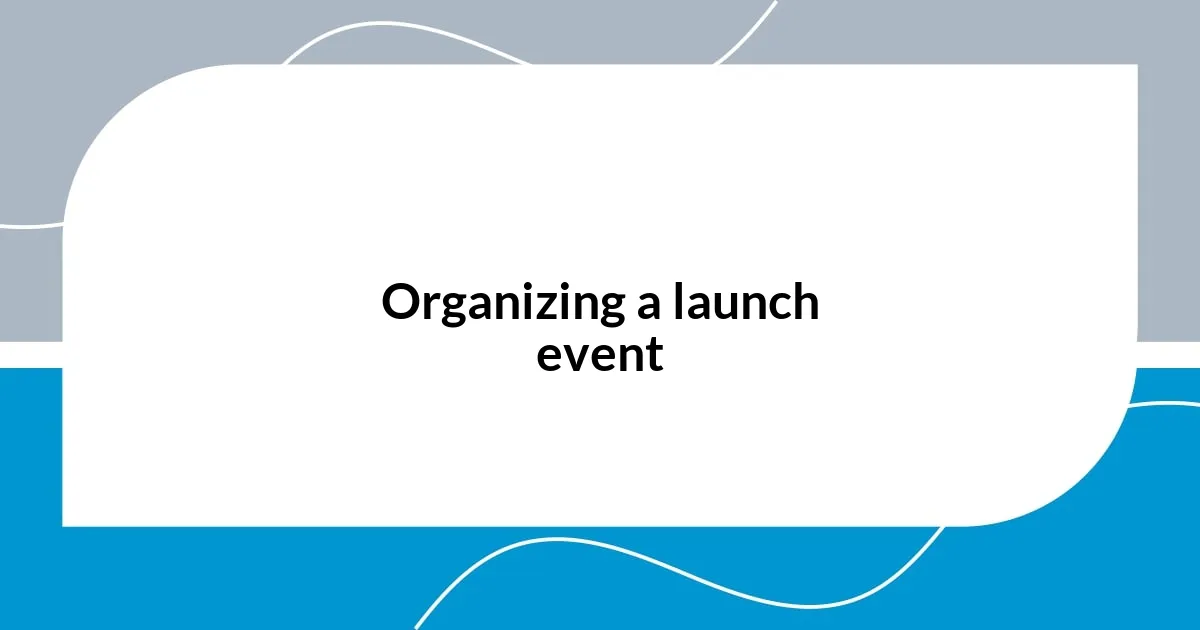
Organizing a launch event
Organizing a launch event was one of the most exhilarating aspects of my book preparation. I recall the moment I decided to host it at a cozy local bookstore, where the smell of coffee mingled with the scent of freshly bound books. The idea was to create an atmosphere that felt like an extension of my narrative, inviting people to step into the world I had crafted. Who wouldn’t be drawn to a space that felt as personal and intimate as the pages they were about to explore?
Planning the event meant juggling numerous details—from selecting the right date to coordinating with the venue staff to ensure everything flowed smoothly. I vividly remember the thrill of curating a playlist that matched the tone of my book. This was more than just background music; it became part of the experience. I hoped that each song would evoke emotions tied to the themes within my story, setting the mood long before I even took the stage.
One particular moment stood out during the event that made all the planning worthwhile. As I engaged with attendees, I could see their genuine excitement as they picked up the book and shared their personal connections to the themes. It was in those conversations, peppered with laughter and thought-provoking questions, that I felt the true impact of my work. This experience confirmed to me that a launch event isn’t just a celebration; it’s a unique opportunity to connect with readers on a deeper level. How could I not cherish that moment, knowing I’d created an environment where my story could resonate?
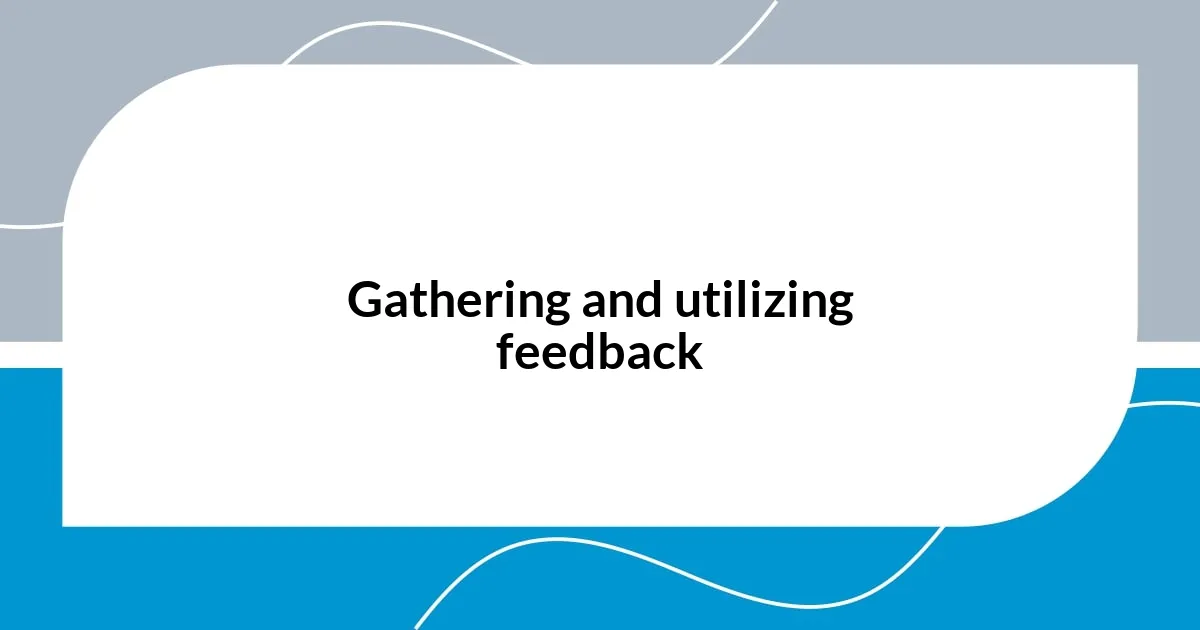
Gathering and utilizing feedback
Collecting feedback was an eye-opening experience for me. As I reached out to beta readers, their insights transformed my understanding of my own work. I remember one reader highlighting a subplot that I thought was minor, yet to them, it resonated profoundly. It was a reminder that what we see as small can often loom large in someone else’s perspective. I found it crucial to view their feedback not just as criticism, but as a treasure trove of ideas for enhancement.
Once I gathered the feedback, the next step was utilizing it effectively. I dedicated time to analyze the comments, prioritizing the ones that aligned with my vision for the book. I distinctly recall sitting with my notebook, jotting down every suggestion, and sometimes even standing back to question why certain elements didn’t resonate with my audience. This reflective process helped me refine my narrative and tighten my pacing, ensuring I was crafting a story that would not only be read but also cherished.
Engaging with readers post-feedback was another important strategy. I made it a point to send thank-you notes to my beta readers, expressing my appreciation for their input. This wasn’t just about courtesy; I wanted them to feel valued for their contributions. In a way, it bridged a connection that went beyond writing. Do you ever wonder how those seeds of feedback can foster a community that supports your work? Personally, I believe it creates a circle of trust and collaboration, where readers feel invested in your journey as much as you do.